Evening light therapy can substantially boost your deep sleep when used correctly. You'll want to start sessions about 8.5 hours after your natural melatonin onset, typically using a bright lamp (4,000 lux) for 45 minutes. Position the lamp 16-24 inches from your face at eye level while you relax or work. Red light therapy is particularly effective, using wavelengths between 620-700 nm to enhance cellular energy and regulate melatonin production. When combined with a proper sleep environment and consistent timing, evening light therapy can increase your total sleep time by more than an hour. Understanding the specific setup and timing details will maximize your sleep-boosting results.
Understanding Evening Light Benefits
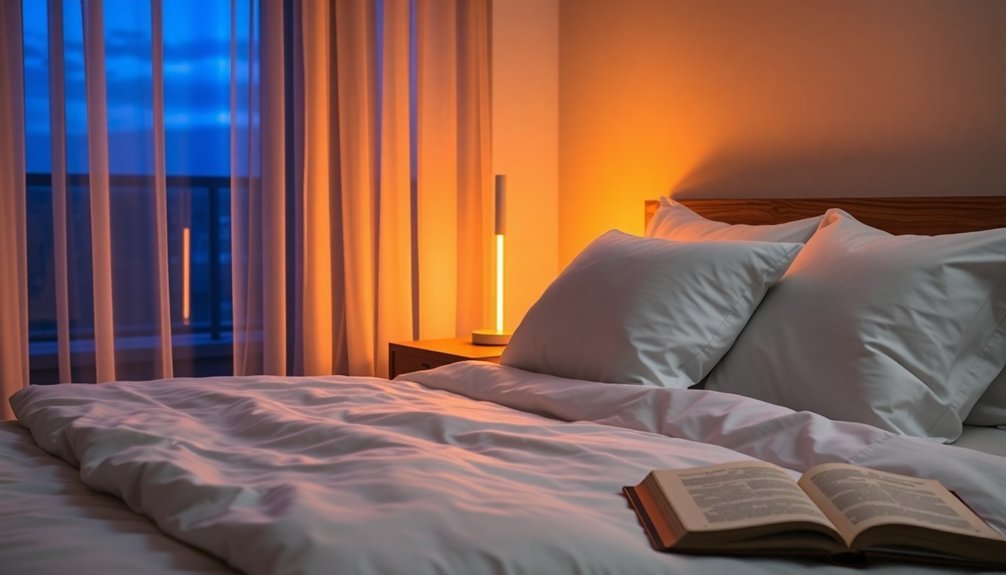
Light exposure in the evening holds remarkable potential for improving sleep quality and regulating your circadian rhythms. When you're exposed to appropriate evening light, you'll experience beneficial phase delays in melatonin production, body temperature, and sleep propensity. This can be particularly helpful if you struggle with early morning awakening insomnia. Using red wavelength lights in your evening routine can provide illumination without disrupting your sleep patterns.
Evening bright light treatment can substantially impact your circadian markers, delaying temperature rhythms by 2-4 hours and melatonin phases by 1-2 hours. If you're a shift worker, you'll notice improved sleep duration, enhanced memory, and better work performance with proper evening light exposure. In fact, bright evening light therapy can increase your total sleep time by more than an hour.
To maximize these benefits, you'll need to time your light exposure carefully. While evening light therapy doesn't cause negative effects on sleepiness, you should consider that its effectiveness might be reduced by your daytime light exposure.
You'll achieve the best results by maintaining consistency in your evening light routine and combining it with good sleep hygiene practices. Remember to adjust your light exposure to match natural patterns for ideal circadian synchronization.
Red Light Science Explained
Through the fascinating process of photobiomodulation, red light therapy harnesses specific wavelengths between 620-700 nm to trigger cellular changes in your body. When you expose your skin to these wavelengths, the light penetrates deep into your tissue, where your cells' mitochondria absorb the light particles.
This interaction kicks off a remarkable chain of events that boosts your cellular energy production. Your mitochondria respond by producing more ATP, the cellular energy currency that powers healing and rejuvenation. The increased energy production strengthens electron transport and oxygen consumption, making your cells more efficient at their jobs. Athletes often experience reduced muscle soreness after incorporating red light therapy into their recovery routine.
You'll find this process particularly beneficial for sleep, as it helps regulate your body's natural melatonin production and counteracts the negative effects of blue light exposure.
The science behind red light therapy's effectiveness lies in its ability to stimulate collagen production, reduce inflammation, and improve blood circulation. Research shows it's especially powerful for tissue repair and skin health. While you won't feel heat during treatment, the light's working at a cellular level, promoting healing and regeneration through increased fibroblast activity and enhanced cellular metabolism.
Selecting Your Therapy Lamp
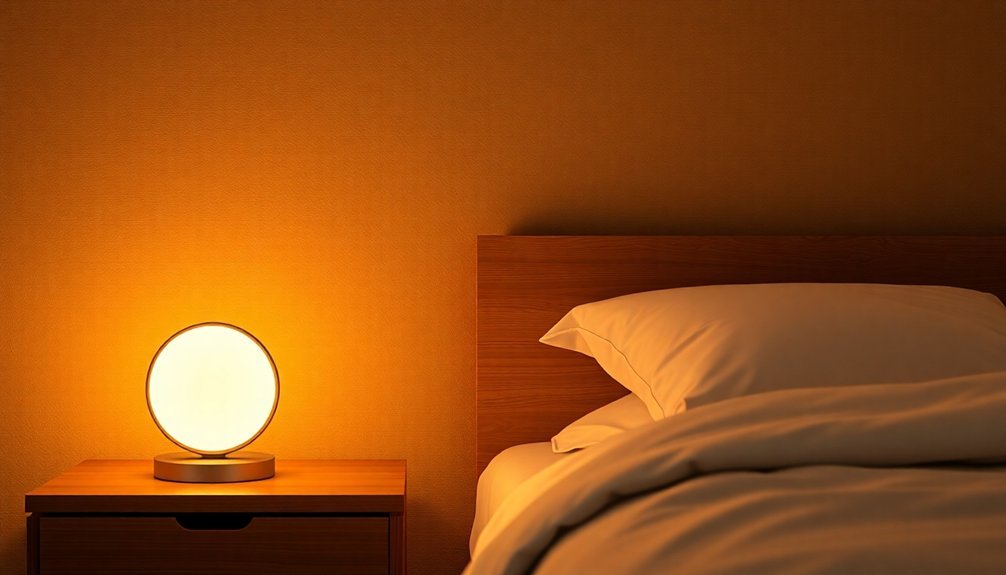
When choosing a therapy lamp for better sleep, you'll need to take into account several key features that directly impact its effectiveness.
Look for a lamp with adjustable intensity settings, which lets you customize the brightness to your comfort level and treatment needs. Make certain it includes essential safety features like automatic shutoff and UV protection to prevent overexposure during your evening sessions. A lamp providing 2,500 to 10,000 lux brightness range ensures optimal therapeutic benefits.
Consider the lamp's design elements carefully. You'll want adjustable height and angle settings to position the light correctly for maximal exposure. The treatment area should be large enough to provide adequate coverage while you're preparing for sleep.
While white light is common for morning therapy, different color options might better suit your evening routine.
Pay attention to quality indicators when making your selection. Choose a lamp from a reputable manufacturer that offers solid warranty coverage and reliable customer support. Check for medical certifications that validate the device's effectiveness and safety standards.
While price shouldn't be your only consideration, weigh the features against the cost to guarantee you're getting value for your investment. Built-in timers are particularly important for evening use, helping you maintain consistent treatment duration.
Optimal Evening Light Timing
Scheduling your evening light therapy sessions correctly can mean the difference between success and failure in improving your sleep. The ideal timing depends heavily on your individual circadian rhythm and melatonin onset patterns. You'll want to begin your therapy sessions about 8.5 hours after your natural melatonin onset for the most effective results. Red light therapy in the evening can boost melatonin production naturally to improve sleep quality.
If you don't know your melatonin onset time, you can use your sleep cycle's midpoint as a reference. Start your light therapy 2.5 to 3.5 hours after your sleep cycle's midpoint for the best results. You'll need about 45 minutes of exposure to bright light (around 4,000 lux) during each session.
| Time of Day | Recommended Action |
|---|---|
| Morning | Get bright sunlight exposure |
| Afternoon | Maintain regular indoor lighting |
| Early Evening | Begin dimming lights |
| Evening | Start light therapy session |
| Bedtime | Complete therapy 2-3 hours before sleep |
Remember that your daytime light exposure affects your evening therapy's effectiveness. Less daytime light exposure typically leads to better results from evening light therapy sessions. Monitor your light exposure patterns and adjust timing as needed for maximum benefits.
Setting Up Your Lamp
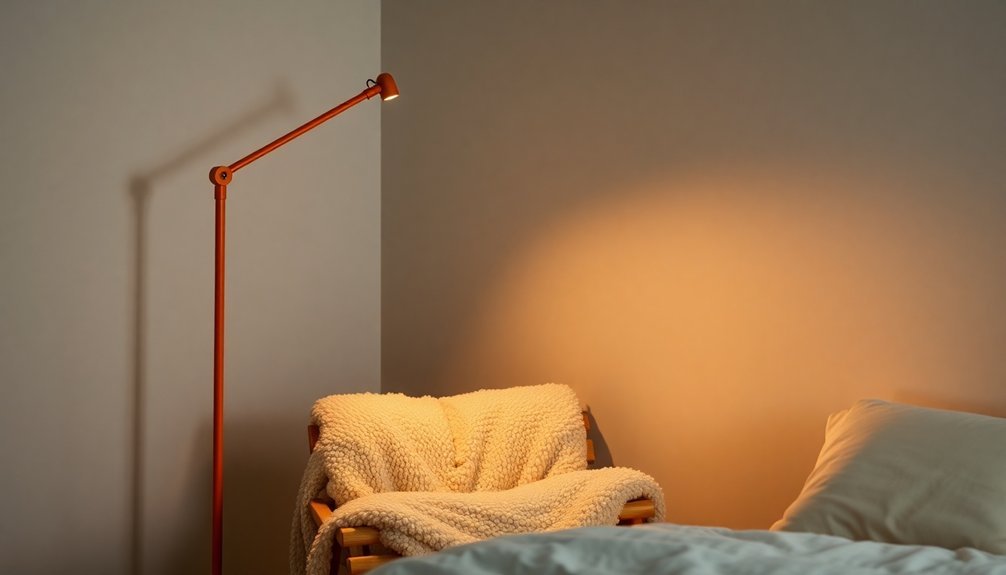
Proper lamp setup forms the foundation of effective evening light therapy. Position your 10,000 lux lamp between 16 to 24 inches from your face at eye level, ensuring the light reaches your eyes indirectly. Don't place the lamp too far away, as this reduces its therapeutic effects, but avoid sitting too close to prevent eye strain and headaches.
You'll want to face the lamp directly rather than at an angle for maximum benefit. Position yourself so the light shines toward your face without making direct eye contact.
Make sure you're seated comfortably, as you'll need to maintain this position for at least 30 minutes during your therapy session. Evening light therapy can disrupt your natural sleep patterns by suppressing melatonin production.
Before using your lamp, clean its surface and verify it meets safety certifications from organizations like the National Sleep Foundation. Follow the manufacturer's instructions carefully when unpacking and setting up your device.
Start by experimenting with different distances and brightness settings until you find your comfort zone. Remember to maintain consistency in your setup routine – this helps establish a regular pattern that maximizes the lamp's sleep-regulating benefits.
Adjust the intensity and duration based on how your body responds to the therapy.
Common Light Therapy Mistakes
While setting up your lamp correctly lays the groundwork for effective therapy, many people make common mistakes that can hinder their treatment results.
The most critical positioning error is sitting too far from your lamp – you'll want to maintain a distance of 16-24 inches for maximum effectiveness. Don't sit at an angle; position yourself directly in front of the lamp to guarantee light reaches your cornea properly. Modern lamps feature low heat emission which allows for comfortable extended sessions without overheating concerns.
Timing and consistency are equally important. You shouldn't use your lamp too late in the day, as it can disrupt your sleep cycle by interfering with melatonin production. Instead, establish a regular morning routine and stick to it daily or at least 3-4 times per week.
Don't forget about maintenance – replace your bulb when it dims or after three years of use. Make sure you're using a lamp that delivers 10,000 LUX, and consider using a diffuser if the light feels too intense.
Always consult your healthcare provider before starting treatment, especially if you have pre-existing conditions like bipolar disorder. Keep track of any side effects and adjust your treatment plan based on your individual needs and response to therapy.
Melatonin and Evening Light
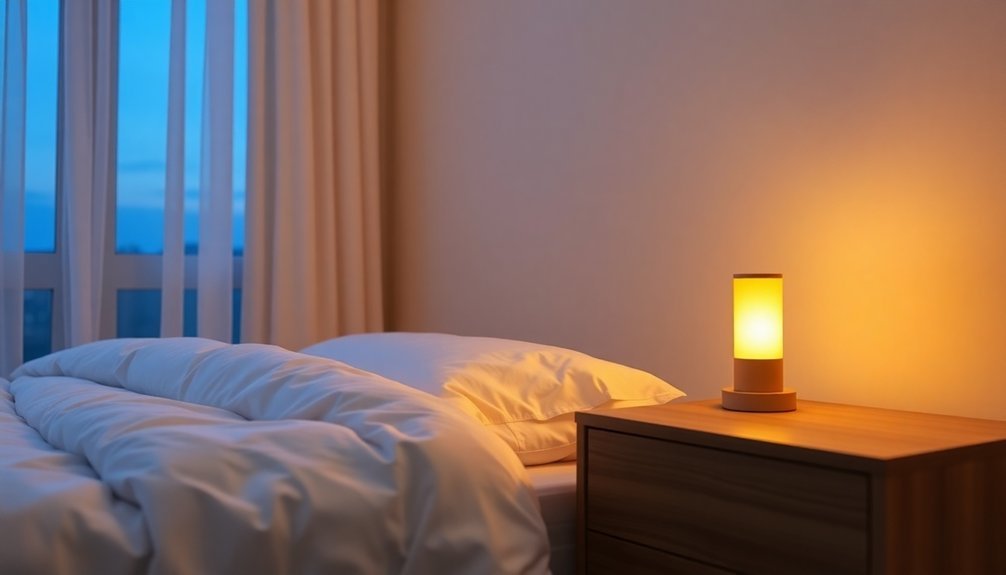
Your body's natural melatonin production peaks in the evening, but exposure to bright light can disrupt this essential sleep hormone cycle.
You'll get the most benefit from evening lamp therapy by keeping light intensity below 8 lux in the three hours before bedtime.
The best window for evening light exposure is early in the evening, around sunset, which allows your melatonin levels to rise naturally as you approach your usual sleep time. Using dim red lights in the evening is ideal since this wavelength has minimal impact on your circadian rhythms.
Natural Melatonin Production Cycle
Understanding melatonin's natural production cycle can help you enhance your sleep quality. Your body's melatonin production follows a precise rhythm controlled by your brain's suprachiasmatic nucleus (SCN), which responds to light signals from your retina.
As evening approaches and light levels decrease, your pineal gland begins converting serotonin into melatonin through a complex process that starts with L-tryptophan.
Your body's melatonin levels typically start rising in the evening, reaching their peak in the middle of the night, and then decline toward morning. Peak production occurs between 3 and 4 AM. This cycle relies heavily on proper light exposure – any bright light, especially blue light, can disrupt production.
You'll produce ideal melatonin when you support the process with proper nutrition, including foods rich in tryptophan and vitamins B3, B6, B12, calcium, and magnesium.
To maintain healthy melatonin levels, you'll need to work with your body's natural rhythm. This means limiting bright light exposure in the evening, maintaining regular sleep schedules, and avoiding substances that interfere with production, such as caffeine, alcohol, and tobacco.
Even dim light can substantially impact your melatonin production, particularly affecting how quickly you'll fall asleep.
Light Intensity Timing Effects
Light's timing and duration play a more significant role in regulating melatonin than its intensity alone. When you're exposed to light for longer periods, even at moderate intensities around 2,000 lux, you'll experience greater shifts in your circadian rhythms compared to brief exposures to bright light. This means you don't need intensely bright light to affect your sleep cycle – duration matters more.
Evening light exposure can dramatically impact your melatonin production, with even dim light (5-40 lux) suppressing melatonin by up to 99% in some cases. What's particularly concerning is that this suppression continues for nearly an hour after the light is turned off.
Blue light from your devices is especially disruptive due to its short wavelength, while warmer, longer-wavelength light has less impact on your sleep patterns.
To protect your natural melatonin production, you'll want to create an evening routine that limits light exposure. Start dimming your lights several hours before bedtime, use low-power lamps with warmer color temperatures, and install blackout curtains in your bedroom. Most importantly, you should minimize screen time, as these devices emit the most disruptive forms of light.
Optimal Evening Exposure Windows
The ideal window for evening light exposure requires careful timing to protect your natural melatonin production. When you're exposed to bright light (5000 lux) in the evening, it can substantially delay your biological bedtime and increase the time it takes you to fall asleep.
Even dim light can disrupt your circadian rhythm and suppress melatonin levels, with effects lasting well after you've turned off the lights.
You'll want to be especially mindful of light exposure during the hours before bed, as your body's natural melatonin production starts ramping up for sleep. The impact is even more pronounced if you haven't gotten enough natural light during the day.
- Limit exposure to bright light at least 3 hours before bedtime
- Use dim red lights for any necessary night lighting
- Switch to blue-blocking glasses if you must use electronic devices
- Increase daytime light exposure to minimize evening light sensitivity
To optimize your sleep-wake cycle, you should gradually decrease your light exposure as bedtime approaches. This means dimming lights, avoiding bright screens, and creating an environment that supports your body's natural shift to nighttime mode.
Measuring Sleep Quality Results
Scientists measure sleep quality through multiple validated tools and metrics that provide both subjective and objective data. You'll find that researchers commonly use the Pittsburgh Sleep Quality Index (PSQI) and Insomnia Severity Index (ISI) to assess your subjective sleep experience, while actigraphy devices track objective measurements like your total sleep time and body movements throughout the night.
When evaluating lamp therapy's effectiveness, researchers focus on key metrics including your ratio of deep sleep, wake time after sleep onset (WASO), and total sleep duration. They'll often monitor your dim light melatonin onset (DLMO) as a vital marker of your circadian phase, which helps determine how well the therapy is working.
You can expect them to pay special attention to your deep sleep ratio, as it's particularly sensitive to evening light exposure.
To guarantee accurate results, you'll typically wear an actigraph with a built-in illuminance detector. This device provides detailed data about your sleep patterns and light exposure throughout the day.
Your response to evening lamp therapy may vary based on your daytime light exposure and individual circadian rhythms, so researchers carefully track these variables when measuring outcomes.
Natural Sleep Enhancement Methods
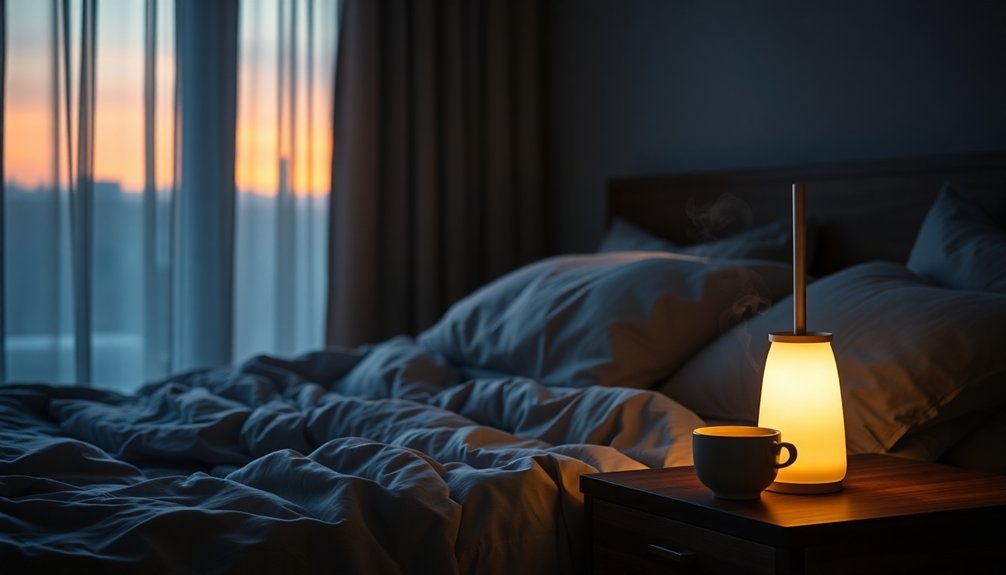
You can effectively reset your circadian rhythm by combining strategic light exposure with consistent sleep-wake times.
To control blue light in your environment, you'll want to use amber-tinted glasses or blue light filtering apps on your devices after sunset.
Making these adjustments, along with maximizing natural sunlight during your desired wake hours, will help align your body's internal clock with your preferred sleep schedule.
Circadian Rhythm Reset Tips
Natural sleep patterns can be disrupted by modern lifestyles, but resetting your circadian rhythm doesn't require drastic measures. You can realign your body's internal clock through gradual adjustments and consistent habits.
Start by shifting your sleep schedule in 15-minute increments until you reach your desired bedtime, and maintain this schedule even on weekends.
Light exposure plays a vital role in regulating your circadian rhythm. You'll want to get bright morning sunlight and create a dark environment in the evening. Consider using a light therapy box with 10,000 lux intensity for 20-40 minutes each morning, positioned 16-24 inches away from you.
- Limit your exposure to electronic devices before bedtime and use blue light filters when necessary
- Create a completely dark sleeping environment using blackout curtains or an eye mask
- Time your exercise and meals strategically to support your new sleep schedule
- Incorporate natural sleep aids like chamomile tea, magnesium-rich foods, or lavender essential oil
Blue Light Control Methods
Modern technology's blue light emissions pose a substantial challenge to quality sleep, but several effective control methods can help protect your body's natural sleep-wake cycle.
Blue light blocking glasses, particularly those with orange or amber shades, serve as your first line of defense by effectively filtering out harmful wavelengths that suppress melatonin production.
You'll find that wearing these glasses in the evening can markedly improve your sleep quality and reduce the time it takes to fall asleep. To maximize their effectiveness, put them on at least 2-3 hours before bedtime. This practice helps maintain your circadian rhythm and promotes deeper, more restorative sleep phases.
Beyond wearing protective eyewear, you can enhance your sleep environment by creating a blue-light-free zone. Install warm-toned bulbs in your bedroom, and avoid using electronic devices before bed.
If you must use devices, activate their built-in blue light filters or night mode settings. These adjustments work together to support your body's natural melatonin production and help prevent the disruption of your sleep-wake cycle, ultimately leading to better sleep quality and improved overall health.
Light Intensity Guidelines
Proper light intensity plays a crucial role in effective evening lamp therapy. When using a therapy lamp, you'll want to aim for 10,000 lux, which is the ideal intensity for treatment. Position your lamp between 16 to 24 inches from your face for the best results, keeping in mind that light intensity decreases with the square of the distance.
For effective therapy sessions, consider these key intensity guidelines:
- If you're using a 5,000 lux lamp, extend your session to 45-60 minutes to achieve similar benefits as a 10,000 lux lamp.
- Keep the lamp's angle within 60 degrees of your line of sight, as intensity drops by half beyond this angle.
- Adjust your exposure time to 1-2 hours if you're using a 2,500 lux lamp.
- Maintain consistent daily sessions of 30 minutes when using a 10,000 lux lamp.
Remember that your surrounding light conditions affect the therapy's effectiveness. If you're exposed to less daylight during treatment hours, you might experience stronger responses to evening light therapy.
Always verify that your lamp has proper UV filtering and certification from recognized organizations like the National Sleep Foundation.
Room Environment Considerations
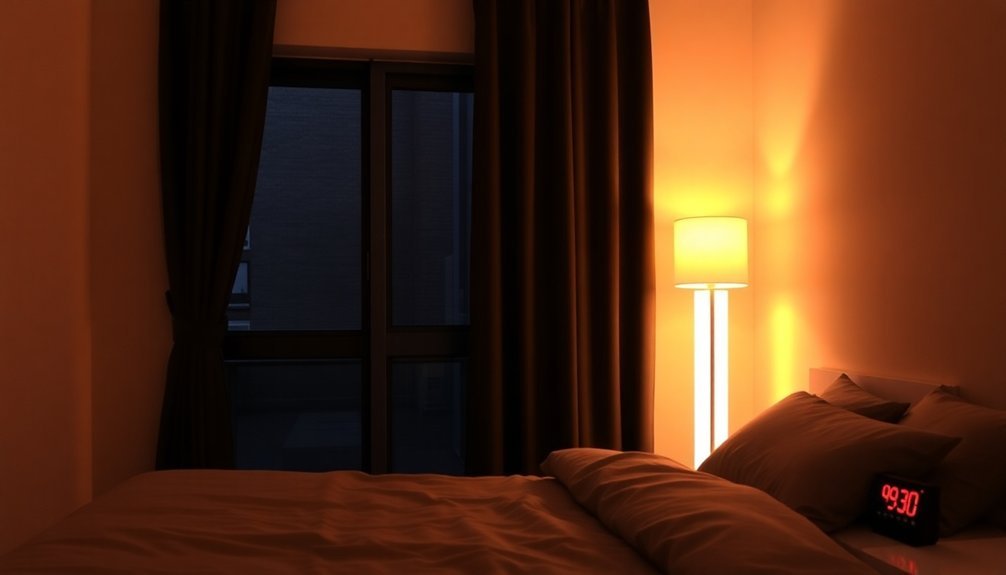
Beyond light intensity settings, creating the right room environment substantially impacts the success of your evening lamp therapy.
Start by positioning your lamp 16-24 inches from your face at eye level, but not directly in your line of sight. This placement reduces glare while maximizing the therapy's benefits.
Your room's overall lighting should support natural circadian rhythms. Use indirect, round, or ring-shaped lighting fixtures instead of harsh LED panels, as they create a more pleasant atmosphere.
In the evening, switch to blue-depleted lighting to prevent melatonin suppression and prepare your body for sleep.
To optimize your sleep environment, guarantee your bedroom is dark, quiet, and cool. Install blackout curtains to block unwanted light, and consider using earplugs or a sound machine to minimize disturbances. Your bed and pillows should be comfortable, supporting quality rest.
Establish a consistent evening routine that includes your lamp therapy sessions. You might want to incorporate relaxing activities like reading or listening to quiet music.
Remember that bright daytime exposure affects evening phototherapy, so maintain balanced light exposure throughout the day.
Combining Therapies For Success
Therapeutic synergy plays a vital role in maximizing your evening lamp therapy results. If you're struggling with sleep issues, combining different treatment approaches can substantially enhance your outcomes.
Research shows that integrating Cognitive Behavioral Therapy (CBT) with other interventions, like evening lamp therapy, can address multiple aspects of your sleep challenges simultaneously.
To optimize your evening lamp therapy, consider these evidence-based combination strategies:
- Pair your lamp therapy with CBT-I sessions to tackle both behavioral patterns and physiological sleep mechanisms, which has shown higher remission rates than single therapies.
- If you're using sleep medication, work with your healthcare provider to gradually incorporate lamp therapy while reducing medication dependency.
- Coordinate your daytime light exposure carefully, as it can impact the effectiveness of your evening light therapy – less daytime exposure often yields better results.
- Consider adding melatonin supplementation to your evening lamp routine, as combined light and melatonin therapies have demonstrated superior phase-shifting effects.
Frequently Asked Questions
Can Evening Light Therapy Affect My Prescription Medications?
You'll need to check with your doctor, as evening light therapy can interact with benzodiazepines and photosensitizing medications. It's important to discuss any light therapy plans with your healthcare provider first.
Is Light Therapy Safe During Pregnancy and Breastfeeding?
Research shows light therapy is generally safe during pregnancy and breastfeeding. You'll want to inform your healthcare provider first, but studies indicate it can help with depression and sleep issues without harming you or baby.
How Does Caffeine Consumption Impact the Effectiveness of Evening Light Therapy?
If you consume caffeine in the evening, you'll reduce your light therapy's effectiveness since caffeine and bright light together suppress melatonin more strongly, disrupting your natural sleep cycle and delaying sleep onset.
Should I Continue Light Therapy While Traveling Across Different Time Zones?
Yes, you should continue light therapy while traveling. It'll help adjust your body clock to new time zones, reduce jet lag symptoms, and maintain sleep quality. Just time your sessions based on travel direction.
Can Evening Light Therapy Help With Night Shift Work Adaptation?
Yes, evening light therapy can help you adapt to night shifts by resetting your circadian rhythm. You'll experience improved alertness during work, better daytime sleep, and reduced sleepiness when using blue-enriched white light.
In Summary
You're now equipped to enhance your deep sleep using evening lamp therapy. By following proper timing, selecting the right red light intensity, and creating an ideal environment, you'll support your body's natural sleep rhythms. Remember to combine your lamp therapy with other healthy sleep practices for the best results. Start with short sessions and adjust based on how your body responds to this science-backed sleep enhancement method.

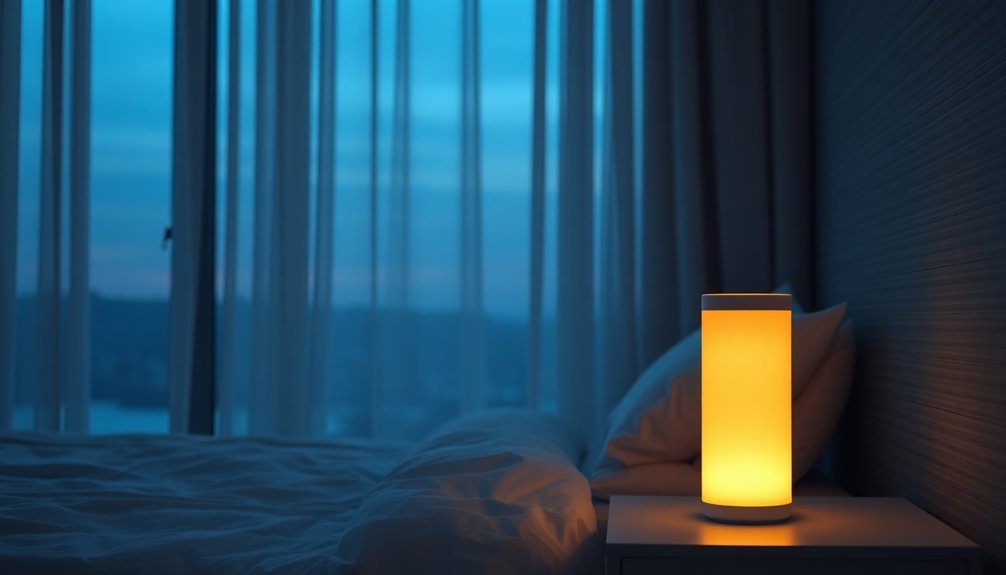



Leave a Reply